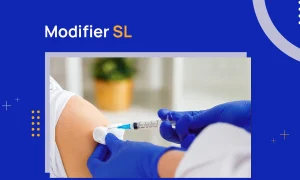Mental health conditions are one of the most prevalent medical issues in the United States. According to the National Institute of Mental Health, over 15.4 million U.S. adults had serious mental illnesses in 2022 alone. This makes accurate mental health billing vital to a practice’s success. Otherwise, all mental healthcare providers will lose billions.
CPT code 90791 is among the most frequently used billing codes. Yet, many billers file it wrongly. This leads to delays in payments, claim denials, and loss of revenue.
In this blog, we will discuss how to effectively bill CPT code 90791. We will focus on the code’s detailed explanation, use case scenarios, important modifiers, and billing guidelines. So, let’s start.
CPT Code 90791 Description
The American Medical Association (AMA) defines CPT code 90791 as “Psychiatric Diagnostic Evaluation” without medical services. 90791 was launched in 2013 to replace the former codes 90801 and 90802. In simple terms, this code is used when a mental health professional conducts an initial or significant assessment of a patient’s mental health status. Evaluations conducted under CPT code 90791 usually entail:
- A thorough review of the patient’s psychiatric and medical history
- A mental status examination
- Initial diagnostic impressions and treatment recommendations
The AMA describes it as an “integrated biopsychosocial assessment”. But what does it mean?
Well, in simple words, it means that the provider considers biological, psychological, and social factors affecting the patient. What makes 90791 different from another closely related CPT code, 90792, is that, unlike 90792, which includes medical services like medication management, CPT code 90791 is purely related to diagnostic services.
Another important point that many billers miss is that, according to the Centers for Medicare & Medicaid Services (CMS), the evaluation under this code should last at least 16 minutes, with an average session lasting around 60 minutes. However, it can extend up to 90 minutes.
If it exceeds more than 90 minutes, you will have to use add-on codes (e.g., 99417) to bill the additional time. Additionally, CPT code 90791 is mostly used for initial diagnosis. It lays down the foundation for subsequent therapy sessions and establishes the medical necessity for treatment.
Appropriate Use Cases for CPT Code 90791
To better understand the usage, let’s look at some scenarios in which you can use CPT code 90791.
- New Patient Evaluations: As we discussed above, the most obvious use of this code is when a new patient visits a practice and requires a mental health assessment, which can then be used to establish a diagnosis and for treatment.
- Change in Clinical Status: 90791 can also be used when a previously treated patient experiences significant changes in symptoms, and the doctor requires a comprehensive reassessment.
- Telehealth Initial Assessments: While primarily used for in-person assessments, CPT code 90791 can also be appropriately billed for telehealth services when proper modifiers are applied.
For example, if a patient comes to the hospital/mental health practice with severe anxiety and panic attacks, the healthcare professional will first conduct an initial evaluation using code
90791. In this evaluation, an assessment of symptoms, patient history, and contributing factors is performed to establish a diagnosis (such as Generalized Anxiety Disorder or Panic Disorder).
Based on this report, he will then create the treatment plan, which will be billed using another relevant CPT code. Please note that the biller must not use CPT code 90791 if a patient has already been through an evaluation within the timeframe specified by the insurance company. This timeframe is usually between 6-12 months.
Modifiers to Append with CPT Code 90791
You may append the following modifiers to code 90791 to provide supplemental information, as shown in the table below.
| Modifier | Description | Usage Context |
|---|---|---|
| 95 | Synchronous telemedicine service rendered via a real-time interactive audio and video telecommunications system | Essential for telehealth services conducted with both audio and video components |
| GT | Via interactive audio and video telecommunication systems (Medicare telehealth services) | Used for Medicare telehealth, though being replaced by 95 in many contexts; some payers still require it |
| 59 | Distinct procedural service | Applied when multiple procedures are performed on the same day that would not typically be reported together |
| 52 | Reduced services | Used when the service provided is less comprehensive than the full service described by the code |
| HF | Substance abuse program | Used when the diagnostic evaluation is specifically part of a substance abuse treatment program |
| HE | Mental health program | Indicates the service is part of a mental health program |
| HR | Family/couple with client present | Used when family members are involved in the evaluation process with the client present |
Reimbursement Guidelines for CPT Code 90791
Following billing guidelines and regulatory standards is essential to avoid 90791 claim denials. Every insurer has its own set of rules. However, almost all follow the following guidelines and standards:
Documentation Requirements
The key to successful billing lies in proper documentation. Comprehensive documentation helps to justify the provided services and reduces the chance of denials. For CPT code 90791, your clinical notes should include:
- Complaint and presenting problem
- Complete psychiatric history
- Relevant medical history
- Family psychiatric and medical history
- Social and developmental history
- Mental status examination findings
- Current medications and medication history
- Substance use assessment
- Risk assessment (suicide, homicide, self-harm)
- Diagnostic formulation with specific DSM-5/ICD-10 codes
- Treatment recommendations and plan
- Session start and end times
- Total face-to-face time spent with the patient
Please note that the documents you append should establish the need for the evaluation and support the diagnosis and treatment recommendations.
Frequency and Limitations
Most payers, including Medicare, restrict 90791 to once per year per patient per provider.
Some private plans allow it every six months, but exceeding these limits risks denials. So, before filing the claim, check the guidelines of the specific insurance provider.
According to CMS guidelines, CPT code 90791:
- Cannot be reported on the same day as an evaluation and management service for the same patient
- Cannot be reported on the same day as psychotherapy services (including crisis psychotherapy)
Final Thoughts on CPT Code 90791
CPT code 90791 is an important mental health billing code and must be used with proper verification and documentation. By following the information and guidelines provided in this blog, you can accurately file first-time mental health evaluations, which will lead to more revenue and fewer claim denials.
If your practice is facing billing issues or you want to outsource its non-clinical operations, contact our consultants for expert support and the best mental health billing services.
FAQs
What is CPT code 90791?
CPT code 90791 is a billing code for psychiatric diagnostic evaluation. It involves an initial assessment of a patient’s mental health condition, history, and symptoms by a licensed mental health professional.
What is the difference between 90791 and 90837?
CPT code 90791 is for an initial psychiatric diagnostic evaluation, while 90837 is for ongoing psychotherapy sessions lasting 53 minutes or more.
Can 90791 be billed for telehealth?
Yes, CPT code 90791 can be billed for telehealth if the service meets payer requirements and is conducted via an approved telehealth platform.
Can you bill 90791 without a patient present?
No, CPT code 90791 requires the patient’s presence because it involves direct interaction for the diagnostic evaluation. However, the patient does not need to be physically present as the session can be made via virtual presence under 90791.



